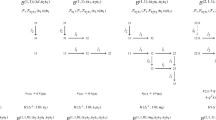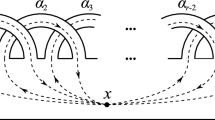Abstract
We use classical invariant theory to construct invariants of complex graded Gorenstein algebras of finite vector space dimension. As a consequence, we obtain a way of extracting certain numerical invariants of quasi-homogeneous isolated hypersurface singularities from their moduli algebras, which extends an earlier result due to the first author. Furthermore, we conjecture that the invariants so constructed solve the biholomorphic equivalence problem in the homogeneous case. The conjecture is easily verified for binary quartics and ternary cubics. We show that it also holds for binary quintics and sextics. In the latter cases the proofs are much more involved. In particular, we provide a complete list of canonical forms of binary sextics, which is a result of independent interest.
Similar content being viewed by others
Notes
The formulae for the discriminant that we use below in the cases \(m=2,3\) differ from the one given in [8] by scalar factors.
This proof was suggested to us by A. Gorinov.
References
Bass, H.: On the ubiquity of Gorenstein rings. Math. Z. 82, 8–28 (1963)
Dieudonné, J.A., Carrell, J.B.: Invariant theory, old and new. Adv. Math. 4, 1–80 (1970)
Eastwood, M.G.: Moduli of isolated hypersurface singularities. Asian J. Math. 8, 305–313 (2004)
Elliott, E.B.: An Introduction to the Algebra of Quantics. Oxford University Press, Oxford (1895)
Fels, G., Isaev, A., Kaup, W., Kruzhilin, N.: Isolated hypersurface singularities and special polynomial realizations of affine quadrics. J. Geom. Anal. 21, 767–782 (2011)
Fels, G., Kaup, W.: Classification of commutative algebras and tube realizations of hyperquadrics. Preprint. http://arxiv.org/pdf/0906.5549v2
Fels, G., Kaup, W.: Nilpotent algebras and affinely homogeneous surfaces. Math. Ann. 353, 1315–1350 (2012)
Gelfand, I.M., Kapranov, M.M., Zelevinsky, A.V.: Discriminants, Resultants and Multidimensional Determinants. Modern Birkhäuser Classics. Birkhäuser Boston, Inc., Boston (2008)
Greuel, G.-M., Lossen, C., Shustin, E.: Introduction to Singularities and Deformations. Springer Monographs in Mathematics. Springer, Berlin (2007)
Huneke, C.: Hyman Bass and ubiquity: Gorenstein rings. In: Algebra, K-Theory, Groups, and Education (New York, 1997). Contemporary Mathematics, vol. 243, pp. 55–78. American Mathematical Society, Providence (1999)
Isaev, A.V.: On the number of affine equivalence classes of spherical tube hypersurfaces. Math. Ann. 349, 59–74 (2011)
Isaev, A.V.: On the affine homogeneity of algebraic hypersurfaces arising from Gorenstein algebras. Asian J. Math. 15, 631–640 (2011)
Kraft, H.: Geometrische Methoden in der Invariantentheorie. Aspects of Mathematics D1. Vieweg, Braunschweig (1984)
Martsinkovsky, A.: Maximal Cohen–Macaulay modules and the quasihomogeneity of isolated Cohen–Macaulay singularities. Proc. Am. Math. Soc. 112, 9–18 (1991)
Mather, J., Yau, S.S.-T.: Classification of isolated hypersurface singularities by their moduli algebras. Invent. Math. 69, 243–251 (1982)
Mukai, S.: An Introduction to Invariants and Moduli. Cambridge Studies in Advanced Mathematics, vol. 81. Cambridge University Press, Cambridge (2003)
Mumford, D., Fogarty, J., Kirwan, F.: Geometric Invariant Theory. Results in Mathematics and Related Areas (2), vol. 34. Springer, Berlin (1994)
Olver, P.: Classical Invariant Theory. London Mathematical Society Student Texts, vol. 44. Cambridge University Press, Cambridge (1999)
Orlik, P., Solomon, L.: Singularities II; automorphisms of forms. Math. Ann. 231, 229–240 (1977/1978)
Saito, K.: Quasihomogene isolierte Singularitäten von Hyperflächen. Invent. Math. 14, 123–142 (1971)
Saito, K.: Einfach-elliptische Singularitäten. Invent. Math. 23, 289–325 (1974)
Sylvester, J.J.: On the calculus of forms, otherwise the theory of invariants. Camb. Dublin Math. J. IX, 85–104 (1854)
Sylvester, J.J.: Tables of generating functions and groundforms for the binary quantics of the first ten orders. Am. J. Math. 2, 223–251 (1879)
Weber, H.: Lehrbuch der Algebra. 2 Auflage, 2 Band. Vieweg, Braunschweig (1899)
Xu, Y.-J., Yau, S.S.-T.: Micro-local characterization of quasi-homogeneous singularities. Am. J. Math. 118, 389–399 (1996)
Acknowledgments
We would like to thank A. Gorinov for suggesting a proof of Proposition 3.1. This work is supported by the Australian Research Council.
Author information
Authors and Affiliations
Corresponding author
Rights and permissions
About this article
Cite this article
Eastwood, M.G., Isaev, A.V. Extracting invariants of isolated hypersurface singularities from their moduli algebras. Math. Ann. 356, 73–98 (2013). https://doi.org/10.1007/s00208-012-0836-7
Received:
Revised:
Published:
Issue Date:
DOI: https://doi.org/10.1007/s00208-012-0836-7




